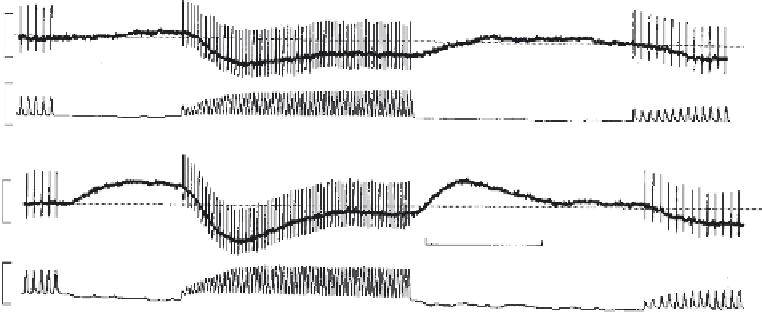Biology Reference
In-Depth Information
A Control
[Ca]
o
1mV
0.2 mM
[Ca]
o
Tension
200
m
N
B Ryanodine
[Ca]
o
1mV
0.2 mM
[Ca]
o
30 s
Tension
80
m
N
Fig. 7
Measurements of [Ca
2
þ
]
o
using double-barreled extracellular Ca
2
þ
MEs in rabbit ventricular
muscle. Local [Ca
2
þ
]
o
and tension are shown starting during steady state stimulation at 0.5 Hz with a
couple of pauses (0.5 and 1 min) and a period of 1 Hz stimulation. Spikes on [Ca
2
þ
]
o
trace are stimulus
artifacts, and bath [Ca
2
þ
]
o
was 0.2 mM. The same protocol was used before (A) and after equilibration
with 1
m
M ryanodine (B; from
Bers & MacLeod, (1986)
, with permission).
several beats. What we showed with other experiments was that this depletion
reflects the filling of SR Ca
2
þ
stores (i.e., net transfer of Ca
2
þ
from the extracellular
space to the SR). Moreover, the rise in [Ca
2
þ
]
o
during rest reflects the gradual loss
of SR Ca
2
þ
that depends on diastolic leak of Ca
2
þ
from the SR and net Ca
2
þ
extrusion by Na/Ca exchange (thermodynamically favored in resting rabbit ven-
tricular muscle;
Fig. 6
A). This also allowed new insight at the time as to exactly
how ryanodine works in cardiac myocytes.
Figure 7
B shows that loss of cellular
Ca
2
þ
during rest is much faster after ryanodine exposure, but that during 1 Hz
pacing the cell (and SR) can take up Ca
2
þ
. This showed that ryanodine makes the
SR leaky, but not so much as to abolish SR Ca
2
þ
uptake (i.e., Ca
2
þ
could still be
driven into the SR). Once the repeated high [Ca
2
þ
]
i
signals stop driving SR Ca
2
þ
uptake, the Ca
2
þ
within the SR is lost very quickly. Thus dynamics of cellular Ca
2
þ
flux balance can be readily assessed by double-barreled Ca
2
þ
-MEs, both with
relatively high time resolution during steady state conditions and for longer
changes that occur in nonsteady state conditions. This makes them a nice comple-
ment to fluorescent indicators and voltage clamp studies.
3. Troubleshooting Ca
2
þ
-Selective MEs
The ME cannot be filled with the ligand:
1. The ligand may be too thick because of the THF evaporation. Redilute PVC
by adding small amounts of THF and stirring the mixture to homogeneity.

